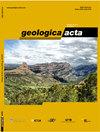Spinels of Variscan olivine hornblendites related to the Montnegre granitoids revisited (NE Spain): petrogenetic evidence of mafic magma mixing
IF 2
4区 地球科学
Q2 GEOLOGY
引用次数: 3
Abstract
Olivine hornblendites (cortlandtites) form part of the Montnegre mafic complex related to late-Variscan I-type granitoids in the Catalan Coastal Ranges. Two generations of spinel are present in these hornblendites: Spl1 forms euhedral crystals included in both olivine and Spl2. Spl2 forms euhedral to anhedral crystals associated with phlogopite and fibrous colourless amphibole forming pseudomorphs after olivine. Compositions of Spl1 are picotite-Al chromite (Fe#: 77.78-66.60; Cr#: 30.12-52.22; Fe3+/R3+: 6.99-21.89; 0.10< TiO2%<0.62). Compositions of Spl2 are pleonaste (Fe#: 37.86-52.12; Cr#: 1.00-15.45; Fe3+/R3+: 0.31-5.21; TiO2%<0.10). The two types of spinel follow a CrAl trend, mainly due to the substitution (Fe2+)-1Cr-1= MgAl, which is interpreted as the result of mixing between two different mantle-derived melts. The compositions of early Spl1 crystals included in olivine are characteristic of Al-rich basalts. More aluminous Spl2 would result from reaction of olivine with a less evolved, Al and K-rich mantle-derived melt after new refilling of the magma chamber or channel. As a whole, spinels from similar examples of Variscan olivine hronblendites also follow a CrAl trend with high Fe# and starting at higher Cr# than other trends of this type. Cr# heterogeneity in the early spinels from these Variscan hornblendites would be inherited from the variable Al content of the mafic melts involved in their genesis.重新考察与黑山花岗质岩石有关的华力西橄榄角闪岩的尖晶石(西班牙东北部):镁铁质岩浆混合的岩石成因证据
橄榄岩角闪岩(cortlandite)是与加泰罗尼亚海岸山脉晚华力西期I型花岗岩有关的黑山镁铁质杂岩的一部分。这些角闪石中存在两代尖晶石:Spl1形成包含在橄榄石和Spl2中的自形晶体。Spl2形成自形到反角体晶体,与金云母和纤维状无色角闪石有关,在橄榄石之后形成假晶。Spl1的成分为皮铝-铬铁矿(Fe#:77.78-66.60;Cr#:30.12-52.22;Fe3+/R3+:6.99-21.89;0.10
本文章由计算机程序翻译,如有差异,请以英文原文为准。
求助全文
约1分钟内获得全文
求助全文
来源期刊

Geologica Acta
地学-地质学
CiteScore
2.50
自引率
6.70%
发文量
13
审稿时长
>12 weeks
期刊介绍:
- Relevant conceptual developments in any area of the Earth Sciences.
- Studies presenting regional synthesis.
- Thematic issues or monographic volumes presenting the results from one or more research groups.
- Short papers reflecting interesting results or works in progress.
- Contributions and results from Research Projects, Workshops, Symposiums, Congresses and any relevant scientific activity related to Earth Sciences.
- Geologica Acta aims to stimulate rapid diffusion of results and efficient exchange of ideas between the widespread communities of Earth Science researchers (with special emphasis on Latinamerica, the Caribbean, Europe, the Mediterranean
联系我们:info@booksci.cn
Book学术提供免费学术资源搜索服务,方便国内外学者检索中英文文献。致力于提供最便捷和优质的服务体验。
Copyright © 2023 布克学术 All rights reserved.
京ICP备2023020795号-1
 京公网安备 11010802042870号
京公网安备 11010802042870号
京ICP备2023020795号-1

Book学术文献互助群
群 号:604180095

 求助内容:
求助内容: 应助结果提醒方式:
应助结果提醒方式:
